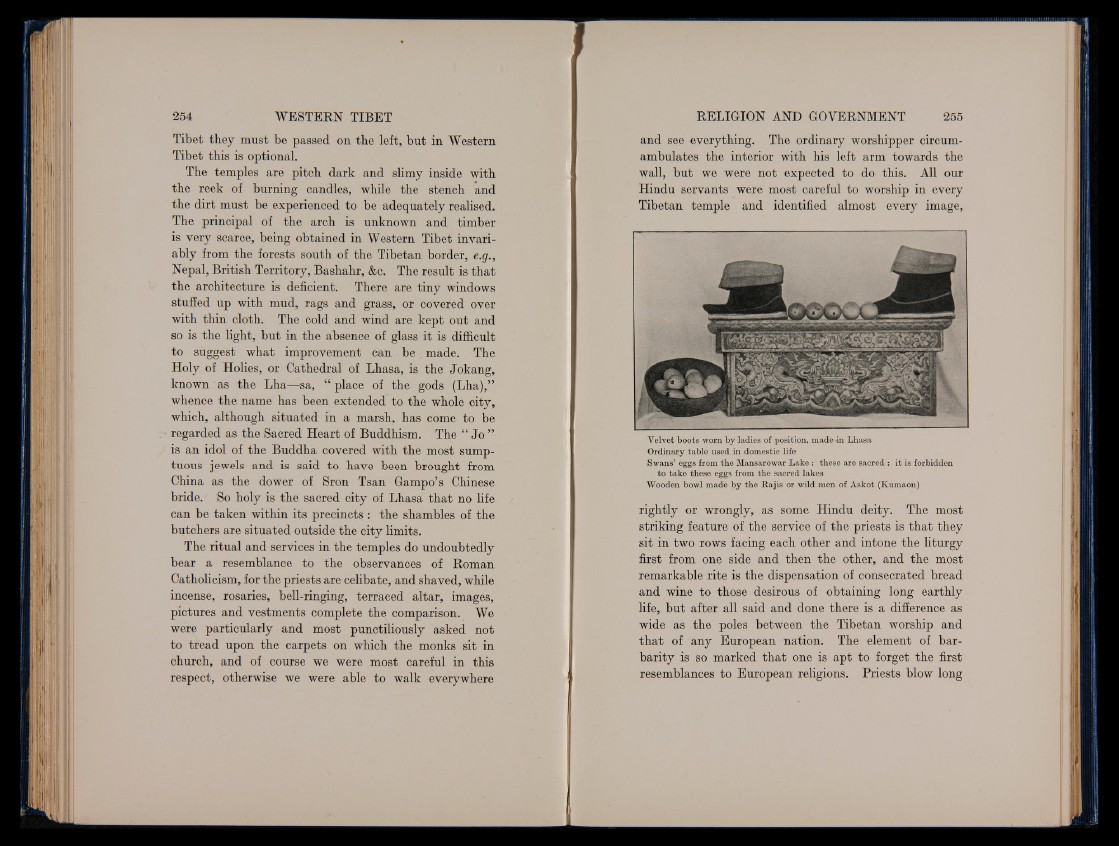
Tibet they must be passed on the left, but in Western
Tibet this is optional.
The temples are pitch dark and slimy inside with
the reek of burning candles, while the stench and
the dirt must be experienced to be adequately realised.
The principal of the arch is unknown and timber
is very scarce, being obtained in Western Tibet invariably
from the forests south of the Tibetan border, e.g.,
Nepal, British Territory, Bashahr, &c. The result is that
the architecture is deficient. There are tiny windows
stuffed up with mud, rags and grass, or covered over
with thin cloth. The cold and wind are kept out and
so is the fight, but in the absence of glass it is difficult
to suggest what improvement can be made. The
Holy of Holies, or Cathedral of Lhasa, is the Jokang,
known as the Lha—sa, place of the gods (Lha),”
whence the name has been extended to the whole city,
which, although situated in a marsh, has come to be
regarded as the Sacred Heart of Buddhism. The “ Jo ”
is an idol of the Buddha covered with the most sumptuous
jewels and is said to have been brought from
China as the dower of Sron Tsan Gampo’s Chinese
bride. So holy is the sacred city of Lhasa that no fife
can be taken within its precincts : the shambles of the
butchers are situated outside the city limits.
The ritual and services in the temples do undoubtedly
bear a resemblance to the observances of Roman
Catholicism, for the priests are celibate, and shaved, while
incense, rosaries, bell-ringing, terraced altar, images,
pictures and vestments complete the comparison. We
were particularly and most punctiliously asked not
to tread upon the carpets on which the monks sit in
church, and of course we were most careful in this
respect, otherwise we were able to walk everywhere
and see everything. The ordinary worshipper circumambulates
the interior with his left arm towards the
wall, but we were not expected to do this. All our
Hindu servants were most careful to worship in every
Tibetan temple and identified almost every image,
Velvet boots worn by ladies of position, made'in Lhasa
Ordinary table used in domestic life
Swans’ eggs from the Mansarowar Lake : these are sacred : it is forbidden
to take these eggs from the sacred lakes
Wooden bowl made by the Rajis or wild men of Askot (Kumaon)
rightly or wrongly, as some Hindu deity. The most
striking feature of the service of the priests is that they
sit in two rows facing each other and intone the liturgy
first from one side and then the other, and the most
remarkable rite is the dispensation of consecrated bread
and wine to those desirous of obtaining long earthly
fife, but after all said and done there is a difference as
wide as the poles between the Tibetan worship and
that of any European nation. The element of barbarity
is so marked that one is apt to forget the first
resemblances to European religions. Priests blow long